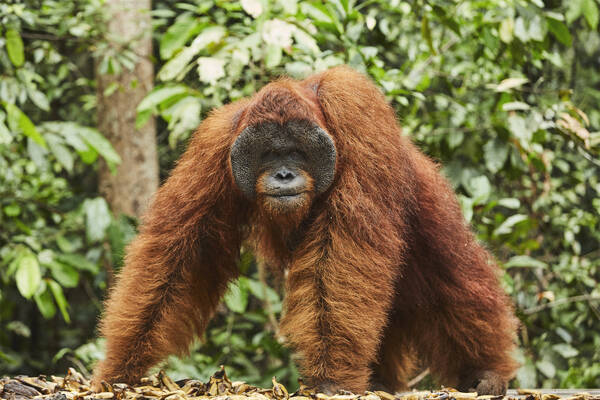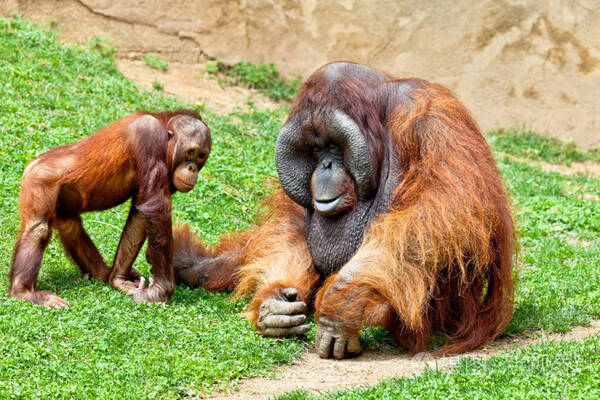Pongo pygmaeus
IUCN
LCBasic Information
Scientific classification
- name:Pongo pygmaeus
- Scientific Name:Pongo pygmaeus, Bornean Orangutan, Orang-outan de Bornéo, Orang-után,Orangutan
- Outline:Primates
- Family:Hominidae Orangutan
Vital signs
- length:78-97cm
- Weight:40-90kg
- lifetime:25-40years
Feature
It is the only orangutan species that is found in Asia.
Distribution and Habitat
Bornean orangutans are distributed in Kalimantan, Indonesia, Sarawak, Malaysia, and Brunei (uncertainty exists). They are the only orangutan species distributed in Asia, with a narrow distribution area. There are not many of them.
Bornean orangutans mainly live in lowland and hilly tropical rainforests, living at an altitude of 800-1500 meters. They live in trees and will go far away with food.
Appearance
The Bornean orangutan has a reddish brown body. It is huge, with males being about twice as long as females. An adult male is 97 cm long and weighs about 60-90 kg; a female is 78 cm long and weighs about 40-50 kg. It has cheek pouches, which are particularly well developed in males. As males age, the skin on their cheeks loosens and expands to both wings to form a huge facial disc. Like humans, it has 12 pairs of ribs, but 4 lumbar vertebrae. There is a central bone in the wrist, which fuses with the bone behind it as it ages. These two points are different from humans. Older people have long and red whiskers. The thumb is very small and the foot is well developed, suitable for grasping objects. The brain volume is 320-400cc for females and 405-540cc for males. The arms are very long, 23-24 cm wide when open, and can reach the ankles when standing; the legs are short and not as strong as the arms; the body hair is sparse, dark reddish brown, and the shoulders and back have more than 20
Details
Bornean orangutan (scientific name: Pongo pygmaeus) is called Bornean Orangutan in English, Orang-outan de Bornéo in French, and Orang-után in Spanish. There are three subspecies.

Male Bornean orangutans live alone, while females live alone or with young orangutans. They are active during the day, spending most of their time foraging. They are not as fast and agile as monkeys, and use their hands and feet to grab branches and move their bodies. They can walk upright on the ground, but they need to rely on their fists and fingers for support, and their waists cannot stand upright. They have strong arm strength and have no other natural enemies except tigers and leopards. It builds a nest with branches on a tree branch 8 to 12 meters above the ground, covers it with leaves, and sleeps on the tree at night. It is usually docile, but very scary when angry. It uses large leaves to cover its body on rainy days. Compared with other apes, it spends more time in trees and can walk on all fours on the ground. It moves slowly and cannot jump between trees. It can only move slowly with its hands and feet. It usually acts alone. The cubs move with their mothers or form temporary small groups, consisting of a male and two or three females carrying the cubs.
Bornean orangutans build nests in trees, flatten nearby branches and vines, and cover them with branches to make a nest that can only be lived in for one night. They build a new nest the next night. They have the slowest reproduction rate of all mammal species, with an interval of about 8 years between births. The gestation period is 235 to 270 days, with one cub per litter, weighing about 1.6 kg at birth. They can grasp things reflexively as soon as they are born, and can grasp the mother's long hair to suck milk. The cubs live with their mothers for about 5 years before living independently. The lifespan is about 40 years. The gestation period is 8-9 months, with one cub per litter, and a lifespan of 25-40 years.

Bornean orangutans are hunted ruthlessly across a wide range of Southeast Asia, as their large bodies and slow movements make them easy targets for hunters. Over the past 60 years (until 2012), the number of Bornean orangutans is estimated to have declined by more than 50%, with the main threats being habitat loss, human expansion, and 80% of the orangutan's habitat has been lost due to illegal logging, including conversion of forests to farmland, especially oil palm plantations, gold mining, fire damage, timber production, poaching and the pet trade. These factors remain the main threats to orangutans throughout Borneo.
Listed in the IUCN Red List of Threatened Species in 2016 ver3.1 - Critically Endangered (CR).
Listed in Appendix I, Appendix II and Appendix III of the Convention on International Trade in Endangered Species of Wild Fauna and Flora (CITES) 2019 Edition Appendix I.
Protect wild animals and stop eating game.
Maintaining ecological balance is everyone's responsibility!








